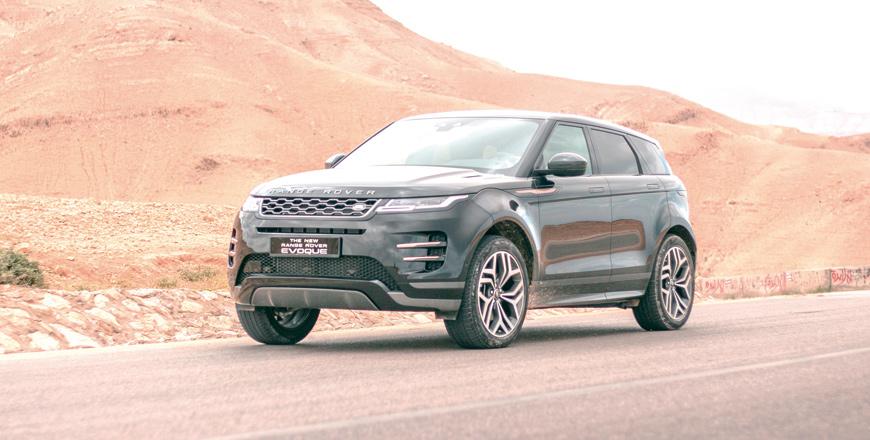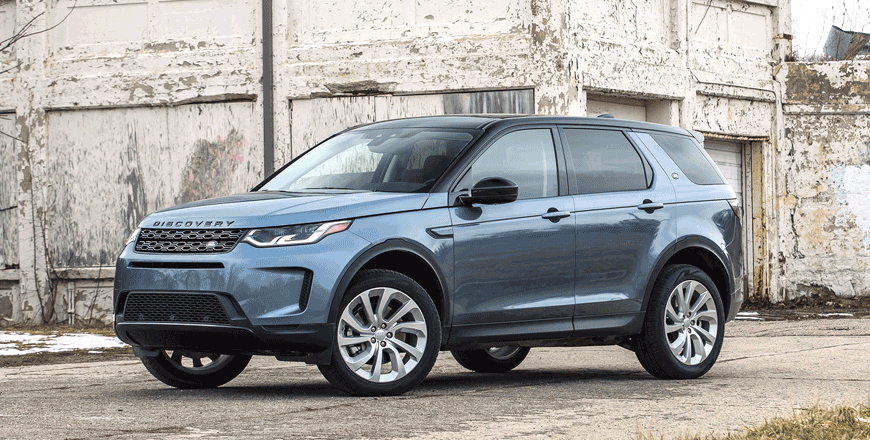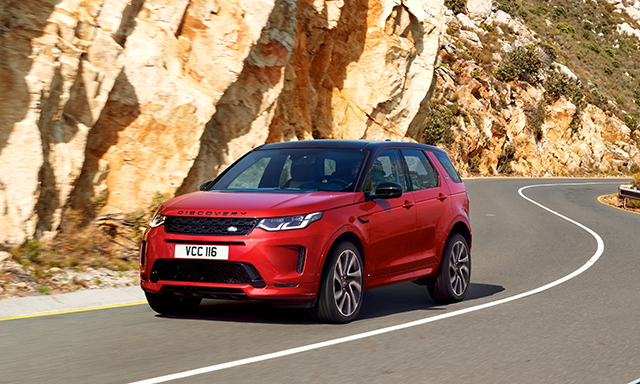You are here
Range Rover Evoque P250 AWD: Evoking a response
By Ghaith Madadha - Apr 29,2019 - Last updated at Apr 29,2019

Photo courtesy of Range Rover
AMMAN — Somewhat controversial with Land Rover traditionalists when first launched in 2011, the compact Range Rover Evoque, however, popularised and broadened the brand’s appeal and accessibility to new group of consumers.
If stark and different then, the original Evoque’s low, wide and heavily stylised design has gone on to inform virtually every Land Rover product since, including the recently launched second generation Evoque.
Introduced earlier this year with new technology, improved space, luxury and efficiency, the new Evoque closely follows the original’s basic design cues, albeit with a more bulging, rounded and haughty demeanor.
Rakish roofline
Slightly longer, taller and with a longer wheelbase for improved legroom, the new Evoque strongly resembles its predecessor, yet has a seemingly bigger and bulkier presence owing to a higher waistline, taller front and rear fascia and higher, slimmer lights.
Replacing the outgoing model’s sharp angular lines and surfacing with bulbous body work, the new Evoque retains many reworked styling elements, including a slim grille and lights with a thin vent below; and an even larger
lower intake. Also present is a similar clamshell bonnet to lend a squinting and moody appearance to its LED matrix headlights.
Meanwhile bulging wheel-arches still interrupt a design element that trails off from the edge of the headlights, and from a side view, the new model retains the rakishly low coupe-like roofline with black pillars, although this time without the choice of a three-door coupe body style.
Along with a higher waistline, the new Evoque features a more sharply rising ridged side line below its new pop-out door handles. From the rear, the new Evoque’s width is accentuated by wider rear lights and a huge lower bumper insert with faux exhaust ports, as driven with the sportier looking R-design package.
Subtle electrification
Powered by petrol and diesel versions of Jaguar Land Rover’s in-house developed 2-litre turbocharged 4-cylinder Ingenium engine in place of its predecessor’s similar Ford-sourced engine, the new Evoque uses a mild hybrid electric vehicle (MHEV) system for its most popular four-wheel-drive automatic gearbox models.
Almost un-discernible in operation, the 48v MHEV system recovers kinetic deceleration energy and stores it in under-body batteries, which allows the engine to automatically switch off at under 17km/h when coming to a stop, and also powers an electric motor that assists the Evoque when accelerating and driving in heavy traffic.
Subtle and virtually undetectable, the Evoque’s electric assistance did; however, seem to compensate for expected turbo lag from idling with better immediate responsiveness than expected.
Driven in the second to top specification P250 guise, the Evoque produces 245BHP at 5,500rpm and 269lb/ft torque throughout a broad, versatile and accessibly responsive 1,300-4,500rpm mid-range.
Not much more powerful than its predecessor but somewhat heavier at 1,818kg, the Evoque P250’s MHEV system and slick-shifting 9-speed automatic gearbox with a broad range of ratios for performance, efficiency and versatility do make it slightly quicker and economic.
Settled and stable
A brisk drive with confident mid-range flexibility despite its heft, the Evoque P250 covers the 0-100km/h in 7.5-seconds, 80-120km/h in 5.1-seconds and is capable of 230km/h, but returns moderate 7.9l/100km fuel efficiency on the combined cycle.
A refined drive with good sound insulation and a reassuringly stable ride at speed, the driven R-Dynamic package version was fitted with the second largest 20-inch alloy wheels and 235/50R20 tyres.
Somewhat firm over rougher more damaged road segments and on gravel trails, this tyre option was fine on smoother roads and provided reasonable comfort over imperfections and gripped corners well. However, entry-level 18-inch wheels proved better on Jordanian roads.
Driven with fixed rate dampers rather than with optional adaptive dampers, the Evoque’s MacPherson strut front and integral link rear suspension with fluid-filled bushes were well set-up to provide a good mix of ride comfort, settled vertical control and good lateral body control through fast and tight corners for the vehicle’s height.
Tidy into corners with little sign of under-steer, the Evoque was also reasonably agile for the segment and allowed one to easily shift weight to the rear outside wheel to tighten a cornering line. Meanwhile, its quick 2.31-turn electric-assisted steering was direct and refined, if somewhat clinical as driven with 20-inch wheels.
Sophisticated solutions
Driving the front wheels under normal circumstances to minimise fuel consumption, the Evoque’s four-wheel-drive reengages the rear wheels for stability, traction and grip.
Primarily designed for road use, but with genuine off-road ability, the Evoque is offered with numerous standard on- and off-road driver assistance systems, including adaptive control, steering assist, lane-keeping assist, blind spot monitoring and autonomous emergency braking.
For off-road driving, the Evoque features Hill Descent, Gradient Release and All-Terrain Progress control systems, as well as a four mode Terrain Response system that leverages and adapts various driver aids, gearbox and throttle for different off-road conditions.
A classy and well-equipped vehicle with a good driving position, the Evoque has a pleasantly up-market feel and design as driven in the luxurious HSE trim level, with good quality materials used in the right places and sophisticated, uncluttered switchgear and infotainment screens.
Spacious in the front, if slightly less so for tall and large occupants in the rear, the Evoque offers good front visibility, but addresses the less generous rear and over-shoulder visibility associated with its sharply descending roofline, ascending waistline and small glasshouse with a standard 360° reversing camera and high mounted rear camera for a wider view with the flick of a button.
Optionally, a front mirror offers unrestricted views for off-road driving and maneuvering in tight confines.
TECHNICAL SPECIFICATIONS
Engine: 2-litre, turbocharged, transverse 4-cylinders
Bore x stroke: 83 x 92.3mm
Compression ratio: 10.5:1 (+0.5:1)
Valve-train: 16-valve, DOHC, continuously variable valve timing, direct injection
Electric motor: Synchronous claw pole rotor
Battery: 46.2v lithium-ion
Gearbox: 9-speed automatic, four-wheel-drive
Ratios: 1st 4.713; 2nd 2.842; 3rd 1.909; 4th 1.382; 5th 1.0; 6th 0.808; 7th 0.699; 8th 0.58; 9th 0.48
Reverse / final drive: 3.83 / 4.544
Power, BHP (PS) [kW]: 245 (249) [183] @5,500rpm
Specific power: 122.6BHP/litre
Power-to-weight ratio: 129.4BHP/tonne (kerb)
Torque, lb/ft (Nm): 269 (365) @1,300-4,500rpm
Specific torque: 182.6Nm/litre
Torque-to-weight ratio: 192.8Nm/tonne (kerb)
0-100km/h: 7.5-seconds
80-120km/h: 5.1-seconds
Top speed: 230km/h
Fuel economy, combined: 7.9-litres/100km
CO2 emissions, combined: 180g/km
Fuel capacity: 67-litres
Length: 4,371mm
Width: 1,904mm
Height: 1,649mm
Wheelbase: 2,681mm
Overhang, F/R: 880/810mm
Track, F/R: 1,625/1,631mm
Ground clearance: 212mm
Water wading: 600mm
Approach/break-over/departure angles: 25°/20.7°/30.6°
Ascent / descent gradient: 45°
Side slope gradient: 35°
Towing, braked / unbraked: 1,800/750kg
Aerodynamic drag co-efficiency: 0.325
Headroom, F/R: 989/973mm
Shoulder room, F/R: 1,438/1,407mm
Legroom, F/R: 1,016/859mm
Boot capacity, min/max: 591-/1,383-litres
Unladen / kerb weight: 1,818/1,893kg
Suspension, F/R: Double wishbones / integral multi-link, anti-roll bars
Steering: Electric-assisted rack & pinion
Turning circle: 11.6-meters
Lock-to-lock: 2.31-turns
Brake discs, F/R: 349mm / 300mm
Tyres: 235/50R20
Related Articles
Low, wide, highly stylised and built on a transverse front-drive based platform, the original Evoque proved equally controversial with Land
A more affordable and family-oriented Land Rover SUV with compact dimensions and plenty of practicality, the Discovery Sport was at home bot
First launched in 2015 and revised for the current model year, the Land Rover Discovery Sport’s subtle aesthetic refresh is combined with a


















